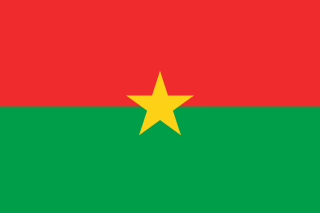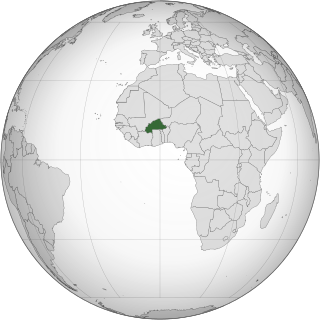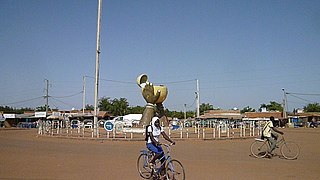
Burkina Faso is a landlocked country in West Africa. It covers an area of 274,223 km2 (105,878 sq mi), bordered by Mali to the northwest, Niger to the northeast, Benin to the southeast, Togo and Ghana to the south, and Ivory Coast to the southwest. As of 2021, the country had an estimated population of 23,674,480. Previously called Republic of Upper Volta (1958–1984), it was renamed Burkina Faso by President Thomas Sankara. Its citizens are known as Burkinabè, and its capital and largest city is Ouagadougou.

Blaise Compaoré is a Burkinabé-Ivorian former politician who served as the second president of Burkina Faso from 1987 to 2014. He was a close associate of the first president, Thomas Sankara, during the 1980s and in October 1987 he led a coup d'état during which Sankara was killed. Subsequently, he introduced a policy of 'rectification', overturning the leftist and Third Worldist policies pursued by Sankara. He won elections in 1991, 1998, 2005, and 2010, in what were considered unfair circumstances. His attempt to amend the constitution to extend his 27-year term caused the 2014 Burkinabé uprising. On 31 October 2014, Compaoré resigned, whereupon he fled to the Ivory Coast. In April 2022, he was found guilty by a special military tribunal of complicity in Sankara’s murder. He is also the longest-serving president of Burkina Faso.

Lesbian, gay, bisexual, and transgender (LGBT) people in Burkina Faso face legal issues not experienced by non-LGBT citizens. Although same-sex sexual acts are legal for both men and women in Burkina Faso, there is no legal recognition of same-sex marriage or adoption rights.

Centre-Est is one of Burkina Faso's 13 administrative regions. The population of Centre-Est was 1,578,075 in 2019. The region's capital is Tenkodogo. Three provinces make up the region.

Kongoussi is a city located in Bam Province in central Burkina Faso, one of the world's poorest countries. It has a population of 53,627 (2019) and is the provincial capital. Mooré, the language of the Mossi people, is spoken along with French, common among those who have attended school or spent time further afield.

A landlocked sub-Saharan country, Burkina Faso is among the poorest countries in the world—44 percent of its population lives below the international poverty line of US$1.90 per day —and it ranks 185th out of 188 countries on UNDP's 2016 Human Development Index .Rapid population growth, gender inequality, and low levels of educational attainment contribute to food insecurity and poverty in Burkina Faso. The total population is just over 20 million with the estimated population growth rate is 3.1 percent per year and seven out of 10 Burkinabe are younger than 30. Total health care expenditures were an estimated 5% of GDP. Total expenditure on health per capita is 82 in 2014.

Human rights in Burkina Faso are addressed in its constitution, which was ratified in 1991. The 2009 Human Rights Report by the United States Department of State noted concerns regarding restrictions on the press and the operation of the judiciary system. In its 2021 report, Human Rights Watch described the human rights situation in Burkina Faso as being "precarious" in light of ongoing violence committed by Islamists, government security forces, and pro-government militias.

The Party of Independence, Labour and Justice is a political party in Burkina Faso. The veteran trade union leader and former general secretary of the African Independence Party (PAI) Soumane Touré is the chairman of the party.
The 2003 Burkina Faso coup d'état attempt was an alleged plot in the landlocked African country Burkina Faso that took place in October 2003. The attempted coup was carried out against long-time strongman President Blaise Compaoré and his CDP regime, and resulted in the imprisonment of several members of the military and political dissidents. Over a decade later, Compaoré would finally be overthrown in the 2014 Burkina Faso uprising.

On 15 January 2016, gunmen armed with heavy weapons attacked the Cappuccino restaurant and the Splendid Hotel in the heart of Ouagadougou, the capital of Burkina Faso. The number of fatalities reached 30, while at least 56 were wounded; a total of 176 hostages were released after a government counter-attack into the next morning as the siege ended. Three perpetrators were also killed. The nearby YIBI hotel was then under siege, where another attacker was killed. Notably, former Swiss MPs Jean-Noël Rey and Georgie Lamon were killed. Responsibility for the attack was claimed by Al-Qaeda in the Islamic Maghreb (AQIM) and Al-Mourabitoun.
Faso soap or Fasoap is the brand of a Burkina Faso-manufactured type of soap, in the development stage, which ostensibly repels mosquitoes and thus protects from mosquito-borne diseases.
Karankasso-Sambla is a department or commune of Houet Province in Burkina Faso.
The Sanmatenga attacks occurred on 8 September 2019 in the Sanmatenga Province, Burkina Faso. In the Barsalogho Department a vehicle transporting people and goods, that was returning from a market, drove over an improvised explosive device (IED). 15 passengers were killed and six were injured in the IED attack. Most of the victims were traders. Meanwhile, around 50 km to the east, a convoy with vans carrying provisions for people displaced by fighting was attacked by gunmen. In this attack, 14 people were killed. It is unknown who carried out this attacks.
The Salmossi mosque attack occurred on the evening of Friday, 11 October 2019 in a mosque in Oudalan Province, Burkina Faso which left 16 people dead and two injured. It happened while the residents were praying inside the Grand Mosque in Salmossi, a village close to the border with Mali. AFP reported that 13 people died on the spot while 3 died later due to the injuries.
The Dolmané gold mine attack occurred on 4 October 2019 near Madouji, Arbinda Department, Soum Province, Burkina Faso. The Dolmané gold mining site was attacked by suspected Islamic terrorists. The attack took place not far from where a bridge linking two northern towns was blown up in mid-September. At least 20 persons, mostly people that worked in the gold mine, were killed and an unknown number of people were injured. Both Islamic State and al-Qaeda have affiliated groups in the region. It is unknown which of the two was responsible for this attack.
The COVID-19 pandemic in Burkina Faso was a part of the ongoing worldwide pandemic of coronavirus disease 2019 caused by severe acute respiratory syndrome coronavirus 2. The virus was confirmed to have reached Burkina Faso on 9 March 2020. The death of Rose Marie Compaoré, a member of the National Assembly of Burkina Faso, on 18 March marked the first recorded fatality due to COVID-19 in Sub-Saharan Africa.

An ongoing war and civil conflict between the Government of Burkina Faso and Islamist rebels began in August 2015 and has led to the displacement of over 2 million people and the deaths of at least 10,000 civilians and combatants.

A coup d'état was launched in Burkina Faso on 23 January 2022. Gunfire erupted in front of the presidential residence in the Burkinabé capital Ouagadougou and several military barracks around the city. Soldiers were reported to have seized control of the military base in the capital. The government denied there was an active coup in the country. Several hours later, President Roch Marc Christian Kaboré was reported to have been detained by the soldiers at the military camp in the capital. On 24 January, the military announced on television that Kaboré had been deposed from his position as president. After the announcement, the military declared that the parliament, government and constitution had been dissolved. The coup d'état was led by military officer Paul-Henri Sandaogo Damiba.
Halidou Tinto is a Professor of parasitology and global health scientist with research that has contributed to understanding and combating malaria in Sub-Saharan Africa. Tinto founded the Clinical Research Unit of Nanaro (CRUN) in Burkina Faso as part of the Institut de Recherche en Sciences de la Santé (IRSS). Tinto is now the Regional Director of the IRSS, and throughout his career he has contributed to the study of antimalarial drug resistance and the development of malaria vaccines.











